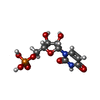+ Open data
Open data
- Basic information
Basic information
| Entry | Database: PDB / ID: 2ylc | ||||||
|---|---|---|---|---|---|---|---|
| Title | Structure of Salmonella typhimurium Hfq in complex with U6 RNA | ||||||
 Components Components | PROTEIN HFQ | ||||||
 Keywords Keywords | RNA BINDING PROTEIN / RNA-BINDING PROTEIN / LSM PROTEIN / RNA CHAPERONE | ||||||
| Function / homology |  Function and homology information Function and homology informationregulation of translation, ncRNA-mediated / regulation of RNA stability / regulation of DNA-templated transcription / RNA binding / identical protein binding / cytosol Similarity search - Function | ||||||
| Biological species |  SALMONELLA ENTERICA SUBSP. ENTERICA SEROVAR TYPHIMURIUM (bacteria) SALMONELLA ENTERICA SUBSP. ENTERICA SEROVAR TYPHIMURIUM (bacteria) | ||||||
| Method |  X-RAY DIFFRACTION / X-RAY DIFFRACTION /  SYNCHROTRON / SYNCHROTRON /  MOLECULAR REPLACEMENT / Resolution: 1.3 Å MOLECULAR REPLACEMENT / Resolution: 1.3 Å | ||||||
 Authors Authors | Sauer, E. / Weichenrieder, O. | ||||||
 Citation Citation |  Journal: Proc.Natl.Acad.Sci.USA / Year: 2011 Journal: Proc.Natl.Acad.Sci.USA / Year: 2011Title: Structural Basis for RNA 3' End Recognition by Hfq Authors: Sauer, E. / Weichenrieder, O. | ||||||
| History |
| ||||||
| Remark 650 | HELIX DETERMINATION METHOD: AUTHOR PROVIDED. |
- Structure visualization
Structure visualization
| Structure viewer | Molecule:  Molmil Molmil Jmol/JSmol Jmol/JSmol |
|---|
- Downloads & links
Downloads & links
- Download
Download
| PDBx/mmCIF format |  2ylc.cif.gz 2ylc.cif.gz | 56.7 KB | Display |  PDBx/mmCIF format PDBx/mmCIF format |
|---|---|---|---|---|
| PDB format |  pdb2ylc.ent.gz pdb2ylc.ent.gz | 41.2 KB | Display |  PDB format PDB format |
| PDBx/mmJSON format |  2ylc.json.gz 2ylc.json.gz | Tree view |  PDBx/mmJSON format PDBx/mmJSON format | |
| Others |  Other downloads Other downloads |
-Validation report
| Summary document |  2ylc_validation.pdf.gz 2ylc_validation.pdf.gz | 777.6 KB | Display |  wwPDB validaton report wwPDB validaton report |
|---|---|---|---|---|
| Full document |  2ylc_full_validation.pdf.gz 2ylc_full_validation.pdf.gz | 777.5 KB | Display | |
| Data in XML |  2ylc_validation.xml.gz 2ylc_validation.xml.gz | 5.3 KB | Display | |
| Data in CIF |  2ylc_validation.cif.gz 2ylc_validation.cif.gz | 6.8 KB | Display | |
| Arichive directory |  https://data.pdbj.org/pub/pdb/validation_reports/yl/2ylc https://data.pdbj.org/pub/pdb/validation_reports/yl/2ylc ftp://data.pdbj.org/pub/pdb/validation_reports/yl/2ylc ftp://data.pdbj.org/pub/pdb/validation_reports/yl/2ylc | HTTPS FTP |
-Related structure data
| Related structure data | 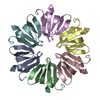 2ylbSC S: Starting model for refinement C: citing same article ( |
|---|---|
| Similar structure data |
- Links
Links
- Assembly
Assembly
| Deposited unit | 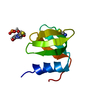
| ||||||||
|---|---|---|---|---|---|---|---|---|---|
| 1 | x 6
| ||||||||
| Unit cell |
|
- Components
Components
| #1: Protein | Mass: 8257.572 Da / Num. of mol.: 1 / Fragment: RESIDUES 1-72 Source method: isolated from a genetically manipulated source Details: THE SEQUENCE IS PRECEDED BY A GA TAG REMAINING FROM THE PURIFICATION TAG. Source: (gene. exp.)  SALMONELLA ENTERICA SUBSP. ENTERICA SEROVAR TYPHIMURIUM (bacteria) SALMONELLA ENTERICA SUBSP. ENTERICA SEROVAR TYPHIMURIUM (bacteria)Strain: LT2 / Plasmid: PET M60 / Production host:  | ||||||
|---|---|---|---|---|---|---|---|
| #2: Chemical | | #3: Chemical | ChemComp-U / | #4: Water | ChemComp-HOH / | Sequence details | THE SEQUENCE IS PRECEDED BY A GA TAG REMAINING FROM THE PURIFICATI | |
-Experimental details
-Experiment
| Experiment | Method:  X-RAY DIFFRACTION / Number of used crystals: 1 X-RAY DIFFRACTION / Number of used crystals: 1 |
|---|
- Sample preparation
Sample preparation
| Crystal | Density Matthews: 2.1 Å3/Da / Density % sol: 40 % / Description: NONE |
|---|---|
| Crystal grow | pH: 8 / Details: 0.2 M NASCN, 20% PEG3350, pH 8.0 |
-Data collection
| Diffraction | Mean temperature: 90 K |
|---|---|
| Diffraction source | Source:  SYNCHROTRON / Site: SYNCHROTRON / Site:  SLS SLS  / Beamline: X10SA / Wavelength: 0.979 / Beamline: X10SA / Wavelength: 0.979 |
| Detector | Type: DECTRIS PILATUS 6M / Detector: PIXEL / Date: Jun 23, 2010 / Details: MIRRORS |
| Radiation | Monochromator: SI(111) / Protocol: SINGLE WAVELENGTH / Monochromatic (M) / Laue (L): M / Scattering type: x-ray |
| Radiation wavelength | Wavelength: 0.979 Å / Relative weight: 1 |
| Reflection | Resolution: 1.3→30.6 Å / Num. obs: 15112 / % possible obs: 100 % / Observed criterion σ(I): -3 / Redundancy: 9.1 % / Biso Wilson estimate: 13.31 Å2 / Rsym value: 0.077 / Net I/σ(I): 16.6 |
| Reflection shell | Resolution: 1.3→1.4 Å / Redundancy: 7.4 % / Mean I/σ(I) obs: 3.6 / Rsym value: 0.69 / % possible all: 100 |
- Processing
Processing
| Software |
| ||||||||||||||||||||||||||||||||||||||||||
|---|---|---|---|---|---|---|---|---|---|---|---|---|---|---|---|---|---|---|---|---|---|---|---|---|---|---|---|---|---|---|---|---|---|---|---|---|---|---|---|---|---|---|---|
| Refinement | Method to determine structure:  MOLECULAR REPLACEMENT MOLECULAR REPLACEMENTStarting model: PDB ENTRY 2YLB Resolution: 1.3→30.595 Å / SU ML: 0.14 / σ(F): 1.99 / Phase error: 18.33 / Stereochemistry target values: ML Details: HYDROGENS WERE REFINED IN THE RIDING POSITIONS. B FACTORS WERE REFINED ANISOTROPICALLY FOR NON-HYDROGEN ATOMS. THE FOLLOWING RESIDUES WERE MODELED AS DOUBLE CONFORMATIONS. CHAIN A, RESIDUE ...Details: HYDROGENS WERE REFINED IN THE RIDING POSITIONS. B FACTORS WERE REFINED ANISOTROPICALLY FOR NON-HYDROGEN ATOMS. THE FOLLOWING RESIDUES WERE MODELED AS DOUBLE CONFORMATIONS. CHAIN A, RESIDUE 27. THE FOLLOWING RESIDUES ARE DISORDERED. CHAIN A, RESIDUES 1 TO 4, 71 TO 72. THE DENSITY FOR THE HEXAURIDINE RNA IS AVERAGED AROUND THE SIXFOLD AXIS. THE ASYMMETRIC UNIT CONTAINS ONLY ONE OF THE SIX URIDINES WITH A PHOSPHATE OCCUPANCY OF 5 OUT OF 6, AND WITH COVALENT BONDS TO ITS NUCLEOTIDE NEIGHBORS. THE BIOLOGICAL UNIT IS AN HFQ HEXAMER BOUND TO THE HEXAURIDINE RNA SUBSTRATE.
| ||||||||||||||||||||||||||||||||||||||||||
| Solvent computation | Shrinkage radii: 0.89 Å / VDW probe radii: 1 Å / Solvent model: FLAT BULK SOLVENT MODEL / Bsol: 46.967 Å2 / ksol: 0.447 e/Å3 | ||||||||||||||||||||||||||||||||||||||||||
| Displacement parameters | Biso mean: 19.4 Å2
| ||||||||||||||||||||||||||||||||||||||||||
| Refinement step | Cycle: LAST / Resolution: 1.3→30.595 Å
| ||||||||||||||||||||||||||||||||||||||||||
| Refine LS restraints |
| ||||||||||||||||||||||||||||||||||||||||||
| LS refinement shell |
|
 Movie
Movie Controller
Controller




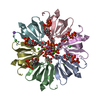


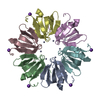





 PDBj
PDBj




